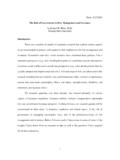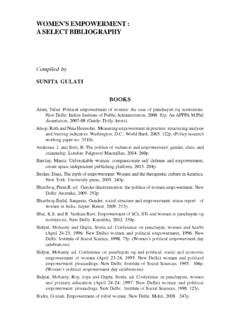Transcription of Constituency Development Funds Workshop
1 1 Constituency Development Funds Workshop Center for International Development Rockefeller College of Public Affairs and Policy university at albany , State university of New York December 8-9, 2009 Introduction The State university of New York Center for International Development (SUNY/CID) kicked off a major project on Constituency Development Funds with a Workshop for 25 academics and practitioners at the university at albany s Rockefeller College on 8-9 December 2009. Constituency Development fund (CDF) is the generic name for a policy tool that dedicates public money to benefit specific political subdivisions through allocations and/or spending decisions influenced by their representatives in the national Workshop in albany capped off initial preparations for a longer-range project in which academics and policy makers will generate comparative information and insights into the operations of CDFs.
2 SUNY/CID committed to provide leadership in the Development of tool boxes of good practices in norms and procedures that can assist policy makers in strengthening the effectiveness of CDFs as tools of participatory policy making. Workshop participants concluded by outlining a broader and comparative policy and research agenda designed to enhance the capacity of CDFs to foster Development and good governance. As economies in the developing world grow and their political systems become increasingly stable, CDFs have become increasingly popular. They are found in a growing and diverse set of developing countries, such as Kenya, Bhutan, Jamaica and Papua New Guinea, as well as in the distributive politics (generally called pork barrel ) in US national and state level policy making.
3 Operations of CDFs remain controversial in donor communities because they raise fundamental questions about democratic theory, the efficacy of government service delivery, the extent to which such service delivery can be made accountable, the role of legislators in selecting Development priorities, and how public participation in policy making can be made more meaningful. It is a propitious time to launch a comprehensive program of exploratory and practical research on CDFs. 2 1 This report employs CDFs as a generic term although such Funds are called electoral Development Funds in Papua, New Guinea, for example. 2 The program and list of participants is appended to this report.
4 The Workshop explored three dimensions of activity surrounding the increasing employment of this policy tool in a diverse set of governments across the globe: 2 Policy making on CDFs, including goals of the Funds , their size, style and conditions for decision making; oversight of CDF; and the relative influence of different individuals and groups in making policy; Effectiveness of CDFs as tools of decentralized Development , including some common pitfalls in implementation, the relationship between CDFs and other local Development projects and administration; and reporting, transparency and accountability of CDF-initiated projects; and Sustainability of CDFs as instruments of Development , including the manner in which CDFs inform representative-constituent relations; the electoral effect of CDFs; the viability of CDFs in different types of electoral systems; and the effect of CDFs on relations among civil society, legislatures and executives.
5 As background, SUNY/CID provided participants with an extensive bibliography of published research on CDFs, summarized some of the common challenges facing CDFs, and provided a matrix comparing characteristics of eight Professor Joel Barkan presented data on Kenya, Malawi, Zambia, South African, Namibia and Mozambique from the African Legislatures Project (ALP) that demonstrated the importance of Constituency politics in Africa even amidst some strong party systems and the great desire of African publics for strong Constituency service. Several presentations helped to frame the Workshop s deliberations: Citing Theodore Lowi s central insight on how the types of policies shape politics, Professor Bob Nakamura outlined diverse of perspectives on CDFs as a tool of policy making and service delivery.
6 Professor Dianna Evans discussed the burgeoning pork projects over the past decade in US policy making and how US politicians frame earmarks as a matter of national interest. Participants viewed a short documentary from International Budget Partnership called It s Our money, Where s it Gone? on efforts of a Kenyan CSO, Muslims for Human Rights (MUHURI) to monitor CDFs in Mombassa, Kenya: or 3 Documents are appended to this report which analyze data on Bhutan, Ghana, India, Jamaica, Kenya, Papua New Guinea, Solomon Islands, and Uganda. CID found insufficient information on the operations of CDFs in an additional 10 governments to include them into the descriptive matrix for the time being.
7 They are: Liberia, Malawi, Malaysia, Mexico, Namibia, Nigeria, Pakistan, Rwanda, Tanzania and Zambia. 3 Rashid Draman (PCC) discussed Ghana s District Assemblies Common fund as a hybrid form of CDF. He described their structure, allocation, the role of MPs in allocating Funds , transparency and accountability of the Funds , and some lessons with the formulation and implementation of the Funds . Shem Baldeosingh (CPA) described the operations of CDFs in a number of systems and concluded that: The focus should remain in addressing the systemic and systematic issues arising within the existing Development financing arrangements for local government (which are many), strengthening the Office of Parliament, and reorienting the relationship between MPs and their constituents to its democratic rather than (apparent) financial basis Scott Hubli (NDI) offered summary observations from the Workshop aimed at contributing to a research agenda on CDFs that reflects the interests of the donor community and addresses themes raised at the conference in long-term studies that go beyond the gotcha moment to explore ways of making CDFs more effective tools of policy and process.
8 The Workshop was structured around the observation that CDFs are increasingly popular vehicle for politically-centered Development that seeks to build relationships between local and central stakeholders, and between stakeholders in government institutions and those in civil society. It focused on practical issues of how CDFs function and on the Development of a research agenda that would permit planners to frame CDFs as a constructive element of a Development strategy, eschewing a consideration of larger, conceptual issues concerning democratic theory and representation. This summary of the Workshop s proceedings is organized around issues of definition, policy making, policy implementation, politics and sustainability, and the steps foreseen to a fuller understanding and tool box on CDFs.
9 It frames the questions raised at the Workshop for further research and Development . What are CDFs? Following from the general agreement that CDFs represent a form of distributive politics and policy making, the Workshop raised four central issues concerning the identification of CDFs as a broader set of policy tools aimed at decentralized Development . First, are CDFs primarily a political project or do they represent efforts to spur good, locally-based Development ? It appears that they are politically driven Development initiatives. Barkan presented information on the importance of Constituency -based politics in Africa in both the supply and demand for Constituency service. So while it is important to take CDFs against the background of national strategies of Development , it also seems clear that a key goal of CDFs is to nurture the integration of diverse communities into a common set of political and social values in support of the existing system.
10 Constituency -based initiatives can protect communities from the impersonal 4 administration of inflexible and centralized state organizations that often overlook individual communities in the name of administrative rationality. Second, how much variation is there in mechanisms of distribution and implementation of CDFs? For example, will a good practice toolbox for Papua New Guinea s EDFs4 also apply to the CDF in Kenya, the CDF in Jamaica, the CDG5 in Bhutan and the MPLADS6 Because the emergence of CDFs makes available substantial political resources to be employed in Development , the universe of policy makers on CDFs is potentially quite in India? To what extent do politicians, administrators and constituencies in each of these places accord similar meaning to each of these funding mechanisms?


